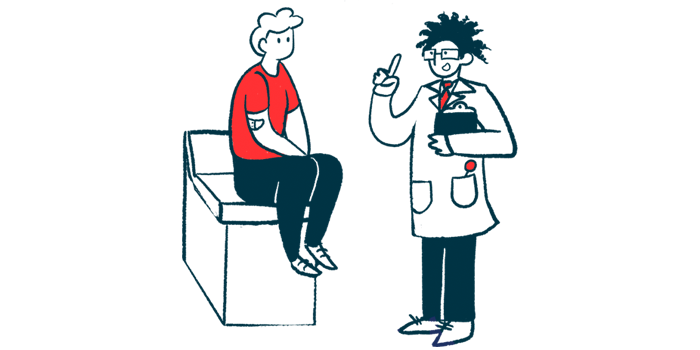Gene mutations explain how man with mEDS kept muscle strength
Case report describes complications including Chiari malformation
Written by |

A man with myopathic Ehlers-Danlos syndrome (mEDS) was able to retain motor function because of the interaction of two separate mutations in the COL12A1 gene, according to a case report.
The man had brain issues as well: Chiari malformation type 1, a condition in which the cerebellum (a brain region at the back of the skull) bulges through the normal opening where the skull joins the spinal canal, and hydrocephalus, the abnormal buildup of cerebrospinal fluid (which bathes the brain and spinal cord) in the brain.
However, he had preserved motor function, which was likely due to his residual production of a working short version of type 12 collagen, the protein coded by COL12A1 and which is faulty in mEDS.
“To our knowledge, this is the first detailed report of an adult with mEDS caused by a compound heterozygous COL12A1 variant, complicated by Chiari I malformations and hydrocephalus,” the researchers wrote. Compound heterozygosity refers to the presence of different mutations in both copies of a gene, one in each copy of the gene.
The case study, “COL12A1-related myopathic Ehlers–Danlos syndrome with Chiari I malformation: A clinical report,” was published in the European Journal of Medical Genetics.
Focus on Chiari
“The presence of Chiari I malformation could help differentiate mEDS from COL6-related disorders,” the researchers wrote. These disorders are caused by mutations in the COL6A gene, and are also characterized by hypermobile joints, muscle weakness, and keloid formation (wound healing with excessive accumulation of scar tissue).
Ehlers-Danlos syndrome (EDS) is a group of genetic disorders typically characterized by symptoms like unusually mobile joints (joint hypermobility), fragile and stretchy skin, and muscle problems.
A type of EDS, mEDS, is marked also by low muscle tone from birth, muscle shrinkage, and a variable degree of improvement in muscle symptoms over time. It is caused by mutations in the COL12A1 gene, which encodes type 12 collagen, a protein required for muscle’s structural integrity and function, resulting in weak muscles with defective structures.
mEDS can be inherited in an autosomal dominant manner — where inheriting only one mutated COL12A1 gene copy is enough to cause disease — or an autosomal recessive manner, in which mutations in both copies of the gene, one inherited from each parent, cause disease.
The team of researchers in Japan described the case of a 30-year-old man in whom two distinct COL12A1 mutations, both previously unreported, were found to be the cause of mEDS with preserved motor function, but linked to brain abnormalities.
He was born at 39 weeks of gestation, with a large head, low muscle tone, muscle weakness, respiratory insufficiency requiring oxygen support, and feeding problems. Despite that, he was able to walk independently at age 2 and run by 4.
He also showed delayed wound healing, excessive accumulation of scar tissue (keloid formation), repeated shoulder and knee dislocations, hearing difficulties, and scoliosis, or an abnormal sideways curvature of the spine. A neurologic assessment at age 7 revealed mild limb weakness, joint hypermobility, a long face, and an abnormally high and narrow roof of the mouth. He underwent surgery to treat knee dislocations when he was 8. His muscle strength remained stable during adolescence, and he performed well academically.
Genetic analysis
At age 30, the man showed severe scoliosis, an increased front-to-back curvature of the spine, stretchy skin, and flat feet with increased bone growth in the heels. He also experienced more pronounced muscle weakness in his hands than in his arms, as well as mildly symmetric upper leg weakness. He was able to walk without assistance.
A brain MRI scan revealed Chiari malformation type 1 and hydrocephalus. Chiari I malformation “has been reported in association with EDS, although it has not been reported in COL6-related disorders,” the researchers wrote. “COL6-related disorders are collagen diseases that present with [muscle disease] and are important differential diagnoses for mEDS.”
Analyses of the man’s muscle tissue revealed a significant reduction of type 12 collagen levels, but normal levels of type 6 collagen.
Genetic analysis identified two novel disease-causing mutations in the COL12A1 gene, one in each copy of the gene, called c.1126C>T and c.6067+1G>A. These resulted in a near absence of a longer form of type 12 collagen, but residual levels of a short form of the protein.
“The residual [production] of the short [form of type 12 collagen] likely contributed to the observed improvements in muscle strength and motor milestones” in this patient, the team wrote.
When they searched the literature, they found nine other mEDS patients with autosomal recessive inheritance, although their long-term prognosis was unclear, as most reports were based on observations during childhood. Only one other man, carrying two copies of the c.395-1G>A mutation, was evaluated at the age of 47 and showed mild disease severity, with the ability to walk.
The case report is the “first description of well-developed motor function, with the underlying mechanisms clearly demonstrated,” the team wrote.




